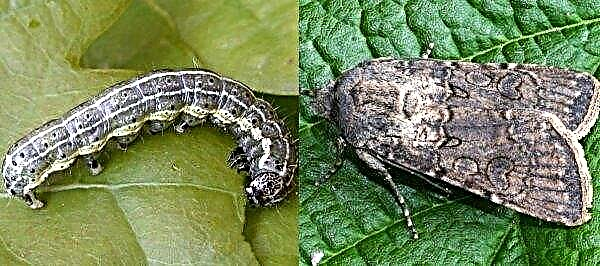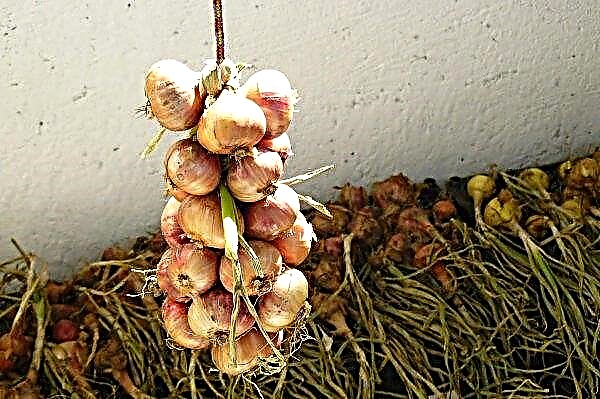Walnut is a tasty and healthy product that can be grown on your site or purchased at many retail outlets. To preserve its properties, after harvesting, the fruits must be dried. Features of the process and further storage are described below.
When and how to collect nuts
The biological sign of ripeness of the culture can be considered the shedding of nuts on the ground when the pericarp is cracked. Cracking usually begins with nuts located on the lower branches of the tree. An additional sign is yellowing of the foliage.
Ripening dates may vary by variety. The early varieties, blooming in spring, are ready to harvest from the end of August, and the fruits of the trees that bloomed in June will ripen by the end of September - mid-October. Walnut does not ripen at the same time, so it is quite difficult to collect the entire crop at a time. In conditions of home gardening, work is performed in several stages or after the ripening of most of the fruits.
When collecting fruits before cracking the pericarp, often use the method of knocking nuts with a stick. This method will negatively affect the condition of the tree, since the branches often break, and the bark receives significant damage and tolerates winter worse. Manual harvesting can be facilitated with a special tool - a roll for collecting walnuts or, for significant plantings, with a tree shaker.Did you know? Leaves, pericarp, and walnut bark can be used as a dye for various natural materials (fabrics, wool, etc.), including for coloring hair.
 Freshly picked nuts should be cleaned of green pericarp as soon as possible, otherwise the kernel may turn black. When working, it is better to wear gloves, as the skin of the hands may become stained.
Freshly picked nuts should be cleaned of green pericarp as soon as possible, otherwise the kernel may turn black. When working, it is better to wear gloves, as the skin of the hands may become stained.
How to dry
Proper drying allows you to maximize the quality of the nut kernel, which is especially important for those who grow the product for sale. Immediately after collection, the moisture content of the fruit is about 40%. After proper processing and drying, this value is reduced to 5–8%, which makes it possible to store for a long time. If the drying was not sufficient and the percentage of moisture is increased, the kernels will be susceptible to mold and darken.
Did you know? In Moldova, there is a long tradition of planting a nut when a child appears in the family.
In large industries, special drying chambers are used, and at home you can use one of the following methods. Before drying, the nuts are freed from the green shell and washed.
Video: How to Dry a Walnut
On air
The most simple and not requiring special resources method requires the following sequence of actions:
- In a sunny area, cover the ground with suitable dense material, such as tarpaulin. If possible, it is better to use boxes with a trellised bottom, which will ensure air circulation.
- Put clean nuts in one layer.
- Dry in the sun. When laying on the material 2-3 times a day, it is desirable to mix.

Drying in air, on sunny days at a temperature of about + 30 ° C, takes 3-5 days. The main disadvantage of this method is the likelihood of precipitation and lowering the average daily temperature, you can not dry nuts in fog or strong dew. It is recommended to cover the fruits at night to avoid exposure to sudden changes in temperature and humidity. Often drying is transferred under the roof using non-residential premises, such as an attic. For such work, nuts must be placed on a wire rack to ensure air access.
 A crop of modest size can be dried in the apartment, while the fruits can be spread out on paper or a newspaper, periodically airing them. The temperature in the room where the fruits will lie should be around + 27 ° C.
A crop of modest size can be dried in the apartment, while the fruits can be spread out on paper or a newspaper, periodically airing them. The temperature in the room where the fruits will lie should be around + 27 ° C.
In the oven
With such drying of nuts, it should be noted that the optimum exposure temperature is + 55 ... + 57 ° C, and the maximum allowable - + 62 ° C. The higher the initial humidity of the product, the lower the drying temperature should be. For the oven, the fruits are pre-sorted by size, then placed the same on the baking sheet.
Important! To make sure that the work is completed, several nuts need to be cracked and the kernel condition checked. If it is still not dry enough, drying should be continued.
The process is recommended to be divided into 2 stages:
- warm the nuts at a temperature of + 40 ... + 45 ° C for about 2.5 hours, leaving the door ajar;
- the last half hour, increase the temperature to + 60 ° C.

In the electric dryer
In the assortment of household appliances stores, you can find electric dryers for fruits and vegetables, which are not forbidden to use for walnuts. The temperature supported by the electric dryer depends on the model of the device. Infrared models operate at temperatures around + 50 ° C, and convection models up to + 70 ° C. The regulator should select the temperature closest to the temperature required for the nuts. The nuts are siphoned off on the included plastic pallets and then follow the instructions for the device. In such a device, drying will take about 5-6 hours.
Are nuts ready how to check
To check readiness, it is necessary to get the kernels of several nuts and examine the inside of the shell. The following signs will indicate product readiness:
- the core is dry, of dense consistency, easily breaks;
- pleasant taste and thin skin;
- the membranes are dry.

What is the best way to dry kernels
The free shells and partitions of the kernel can be dried in the sun by placing them on a suitable tray and stirring occasionally. The average duration of such drying is 2-3 days. You can also use the oven by setting the temperature in it to + 50 ° C and spreading the nuts in a thin layer on a baking sheet.
It will take about 40 minutes, depending on the amount and degree of frying desired. Before direct use, a small amount of kernels can be dried in a preheated pan with constant stirring.
How to store at home
Dried walnuts can be stored in wooden or plastic crates, bag or nets. The container must be clean and dry. Containers should be located in dry places with good ventilation, where the temperature is maintained within + 5 ... + 10 ° C, and air humidity is about 60%. In this form, fruits can be stored for up to 3 years.
Dried peeled kernels can be stored in the refrigerator for up to 1 year, in the pantry or basement for up to 4 months. Up to 3 years, nuts frozen at -18 ° C can retain their beneficial properties. After defrosting, the kernels are calcined in the oven or in a pan.
Compliance with the technology and drying temperature is necessary to ensure the taste properties of the nut. This process also significantly affects the subsequent storage of the product. Depending on the number of fruits and environmental conditions, you can choose the appropriate drying method for each particular farm.












